Contents
1. The prayers offered during shraddha
1.1 The prayers offered at the end of the shraddha ritual
2. Regulations associated with performing shraddha when obstacles of purity-impurity are faced
3. The effects of the shraddha ritual
4. Types of shraddha performed in Pitrupaksha
4.1 Importance of Bharani shraddha
4.2 Importance of Avidhawa Navami
4.3 Importance of Trayodashi and Chaturdashi of Pitrupaksha
4.4 Importance of Sarvapitri Amavasya
1. The prayers offered during shraddha
'उदीरतामवरउत्परासउन्मध्यमा:पितरसोम्यास:।
असुंयईयुरवृकाऋतज्ञा:तेनोऽवन्तुपितरोहवेषु।।' -ऋग्वेद,मंडल१०,सूक्त१५,ऋचा१
Meaning : Let the ancestors residing on Earth attain an evolved region. Let the ancestors who are in heaven, that is, at a higher plane of existence, never degrade. Let the ones who are at a medium plane of existence, attain a higher plane. Let the ancestors who symbolise the Truth protect us.
Also, prayer is offered to the ancestors for the continuation of the lineage, ‘O Pitru-deities, give birth to a son like Ashwini Kumar, who is beautiful, healthy and who can fulfil the wishes of Deities, ancestors and all humans.
1.1 The prayers offered at the end of the shraddha ritual
A. 'गोत्रंनोवर्धताम्।'
Meaning : Let our lineage (gotra) grow. To this the brahmins bestow blessings, ‘Let your lineage grow.”
B. 'वीरंमेदत्तपितर:।'
Meaning : O ancestors, give me a valiant son.
Another prayer is, 'Since the time of the origin of the Universe to date, whoever was born in the lineage of my mother and father and all the servants from these two lineages and my past births, those supported by me, those serving me, friends, disciple, pets, the plants and trees planted and cut by me, the close relatives, those who incurred favours from me and those who bestowed favours on me, get the food offered by me.
It is evident from this prayer that the Hindu Dharma teaches us to express gratitude not only to our own but also towards our benefactors, other beings and trees and plants.
2. Regulations associated with performing shraddha when obstacles of purity-impurity are faced
A) If there is impurity due to birth or death in the family on the day of the shraddha, then after its completion consume panchgavya, change the Holy thread and do shraddha. Alternatively, perform shraddha on the first no moon day after the impurity is over.
B) After commencing the ritual of shraddha if impurity due to birth or death occurs in the family but outside the house, then do not follow the regulations of impurity till the completion of the shraddha. If it happens in the house, then stop the shraddha and only after the observance of impurity is completed, do the shraddha again.
C) If the wife of the one who performs the shraddha has menses, then Mahayala can be done any time after those five days. When the lady performing the shraddha has menses then no regulations need to be followed.
D) If the shraddha falls on Ekadashi, then the person performing the shraddha should merely smell the meal of the shraddha and offer it to a cow or one should perform Hiranya-shraddha.
Hiranya-shraddha is a shraddha done merely by offering donation (dakshina) without offering meal.
E) During eclipse, take a bath and do shraddha even if there is impurity.
Here two points become evident. One is that every ritual has been considered subtly from a worldly perspective in Sanatan Hindu Dharma. The second is that women can also perform shraddha.
3. The effects of the shraddha ritual
For the subtle body (linga deha), the interval from the time of death to the next birth is similar to that of a foetus in the womb. Due to the mantras of the shraddha, the blessings of the brahmins, the good wishes of the relatives and pinda-dan etc. the deceased ancestors acquire a protective sheath and get the momentum to progress.
4. Types of shraddha performed in Pitrupaksha
4.1 Importance of Bharani shraddha
Performing shraddha on the chaturthi or panchami on the Bharani asterism in the Pitrupaksha has a special importance. If possible doing the shraddha on the Bharani asterism in addition to the tithi of death of the person helps the subtle body of the dead to be liberated from the form of being of the dead.
Reason underlying getting fruit equivalent to doing shraddha in Gaya by doing it on the Bharani asterism: There is a subtle cover of desire-frequencies associated with the Absolute Earth and Water Principles on the gross structure of the land of Gaya. This cover is contained in a triangular structure. Hence, performing shraddha at this place is more beneficial for the deceased ancestors’ whose inferior level desires have remained unsatisfied.
The Bharani asterism that falls in the Pitrupaksha is also made of a triangle of three stars. The Deity of this triangle is Lord Yama. The Yama frequencies active in the Universe in higher proportion on this day are associated with desire-energy. When performing shraddha on this tithi, the desire-frequencies on Earth associated with this asterism are activated. Due to this, the place of shraddha becomes akin to that in Gaya. In the ritual of shraddha performed on the Bharani asterism, the Yama frequencies are activated in higher proportion. The deceased ancestors benefit from these frequencies.
4.2 Importance of Avidhawa Navami
The woman who dies before her husband is called ‘avidhawa’. Her shraddha is performed on the tithi of Navami of Pitrupaksha. So this Navami is called ‘Avidhawa Navami’.
Method of performing the shraddha of a dead married woman on Avidhawa Navami: The shraddha of a dead married woman should be performed on the Navami of the Pitrupaksha by the son or the husband. In this shraddha married women are served a meal and ritualistically offered a coconut, sari and a blouse piece. As long as the husband is alive, both the Avidhawa Navami and yearly shraddha should be performed.
4.3 Importance of Trayodashi and Chaturdashi of Pitrupaksha
On the tithi of Trayodashi, a ritual of Kakabali is performed for the dead children. On the day of the Chaturdashi of Pitrupaksha, the shraddha of those who died in accidents is performed.

Kakabali
4.4 Importance of Sarvapitri Amavasya
The Amavasya that falls in the Pitrupaksha is the last tithi of Pitrupaksha. If it is not possible to perform shraddha on any day of the entire year, it is very essential that a shraddha be performed for all the dead on the tithi of Sarvapitri Amavasya. According to the Scriptures, the Amavasya of the Pitrupaksha is the most appropriate tithi for the ritual of shraddha.
For this reason, shraddha has been recommended in the religious Scriptures. Instead of shraddha, on this day some people offer food to the poor or money to a school as per their mind. By doing this no spiritual benefit is gained.


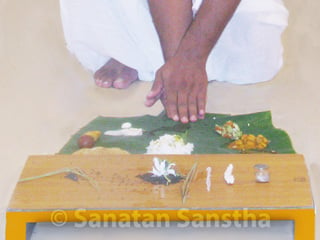 Method of serving food during Shraddha ritual
Method of serving food during Shraddha ritual Traditions observed in different countries for the liberation of deceased ancestors
Traditions observed in different countries for the liberation of deceased ancestors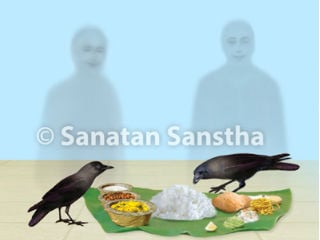 How to perform Mahalaya shraddha in Pitrupaksha during the Coronavirus pandemic ?
How to perform Mahalaya shraddha in Pitrupaksha during the Coronavirus pandemic ?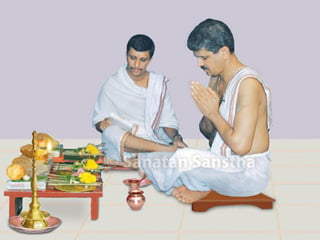 What are three historically established phases of Shraddha?
What are three historically established phases of Shraddha?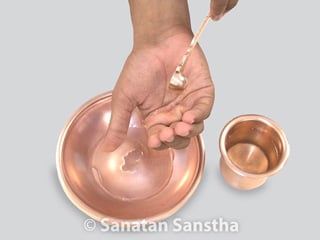 What is the method of performing Tarpan and Pitru tarpan ?
What is the method of performing Tarpan and Pitru tarpan ?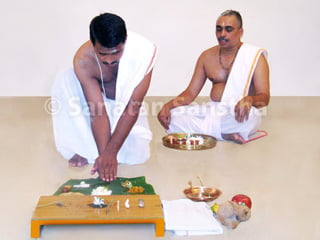 When should the Shraddha be performed ?
When should the Shraddha be performed ?
Who we call while performing monthly ceremony.
Namaskar,
You can call local purohit (priest) to perform Shraddha.